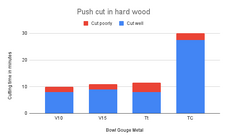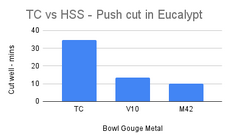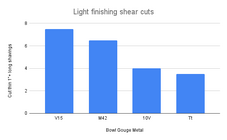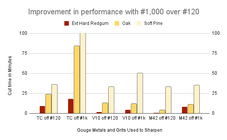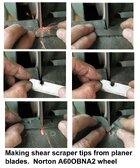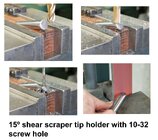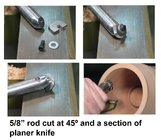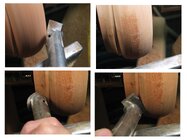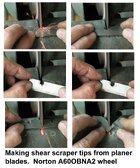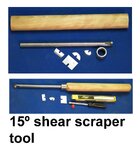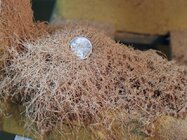+1. Shear scraping yields a better surface both on the inside and outside of a bowl.I turned for over 35 years before anyone "invented" the current negative rake scraper. I bought a negative rake scraper, and now it's in my misfit, unused tool drawer. Most of us used the Irish grind bowl gouge, skew, or freshly ground scraper to do fine scraping in the past. I still think a fine burr on a big scraper is a better tool. A negative rake scraper is NOT a necessity. It is a great way to spend money if that is your goal.
-
December 2025 Turning Challenge: Single Tree! (click here for details) -
Congratulations to Bob Henrickson, People's Choice in the November 2025 Turning Challenge (click here for details) -
Congratulations to Steven Gordon for "Dropped Ice Cream Cone" being selected as Turning of the Week for December 8, 2025 (click here for details) -
Welcome new registering member. Your username must be your real First and Last name (for example: John Doe). "Screen names" and "handles" are not allowed and your registration will be deleted if you don't use your real name. Also, do not use all caps nor all lower case.
You are using an out of date browser. It may not display this or other websites correctly.
You should upgrade or use an alternative browser.
You should upgrade or use an alternative browser.
finish scraping
- Thread starter Kevin Jenness
- Start date
+1. Shear scraping yields a better surface both on the inside and outside of a bowl.
I stopped trying to shear scrape inside bowls with an Ellsworth grind. It doesn't work. Do you mean with a scraper?
Yes, shear scraping with a round nose scraper on the inside of the bowl and with a square end scraper reground into a refiner on the outside of the bowl.I stopped trying to shear scrape inside bowls with an Ellsworth grind. It doesn't work. Do you mean with a scraper?
I have seen a number of turners who use a swept back grind on the inside of a bowl with the handle held level. That is NOT a shear scrape, which to me means held at an angle. At best, that use of a swept back gouge would be more of a NRS than any kind of shear scrape. I do have one video dedicated to that topic.
robo hippy
robo hippy
I have some HSS, some M42 and a lot of 10V steel and I have never did a test as to how long they last as I have left that for others. And there have been many of those and it stands that in terms of lasting in sharpness the ongoing conclusion is that (not including 15V) its 10V, then M42 and then HSS. Remember that when a pro tells you that what he is using is the best its because he's getting something for using them or he is selling them.
I'm one of those that has done a lot of my own testing of the different woodturning tool steels and can say with some confidence that tool performance can depend partly on what it is being used for. With heavy push cuts in very hard wood I found little difference between V10 and 15V....
But M42 did just a little less well on the same test runs...
However, with fine shearing cuts the M42 outperformed V10...
Because of its fine carbide structure the M42 also benefited more than 10V from being ground on a finer #1k grit wheel for turning medium to harder woods, as does Tungsten Carbide...
In my testing V15 always outperformed V10, but only marginally at times. Whether it is worth the extra cost is a judgement for each turner. I've been using V15 for decades now and I have never found it to be chippy and I do spend more time looking at edges under magnification than many other turners.
So, it is not a s simple as this steel is better than that steel. In most non-production workshops there will be very little difference noticed by most turners between these steels. If you want a quantum improvement you have to go to very fine-grained TC and the diamond grinding required with that.
I'm a little less cynical than Bill about pro-turner's recommendations, they have to make a living, but I always reserve my opinions until I've done my own testing. I've lived through all of the hype over the decades with each successive new development in tool steel and I ignore almost everything that retailers 'spruke'.
I think it is Cindy Drosda who says, 'we are just one tool away from turning greatness'. In my time basic HSS was the most significant development in turning tool steels and turning greatness has been achieved with just that by many of the great turners. IMO, the newer super steels are nice to have, but in no way essential to great turning. I believe that @Odie on this forum only uses vanilla HSS tools and it certainly hasn't prevented him from doing some excellent work.
Odie
Panning for Montana gold, with Betsy, the mule!
I believe that @Odie on this forum only uses vanilla HSS tools and it certainly hasn't prevented him from doing some excellent work.
Yes, this is true Neil......
Quite a few turners swear by the exotic steels, and I believe they absolutely do hold an edge longer........But.......I also believe that many turners spend way too much time, money, and effort to attain an edge that will last longer.
The whole point in bowl turning is to have the sharpest edge possible from the first cut to the last cut, and that is just as possible with the "vanilla" M2 steels that I use. I will concur that the M2 steels will dull a little faster than the exotic steels.......but, re-sharping to a keen edge is so quick and easy (only seconds of time, as a matter of fact), that the exotic steels just don't make a lot of sense to me.
Besides that, when I use my exotic steels, I tend to use an edge that could benefit from re-sharpening a little longer than I should. A tool that is only slightly dulled will still cut, and the difference between it and a freshly sharpened edge is not that noticeable.....until it's time to start sanding......then the difference is a little more obvious.
A turning tool that dulls faster is a benefit to establishing a finely tooled surface........why?........because the difference between M2 steel and the dulling rate of an exotic steel tool is much more clearly defined. Because of that, there is much less "guesswork" in knowing exactly when it's time to resharpen.
In my opinion, there are benefits to the exotic steels, but there are big and unfortunate trade-offs to use them......specifically because they tend to keep a turner turning longer than they should, when re-sharpening is what's called for.
=o=
Last edited:
I've never had luck trying to sheer scrape the INSIDE of a bowl with a swept back gouge. Even when I try to tilt the gouge up VERY high, so the sheer angle is fairly extreme, it just doesn't work. I don't know the specific science behind it, but sheer scraping the outside of a bowl or platter, or even the rim of a platter (which IS possible in my experience), is usually working on a flat or convex surface. Something about the concave surface of the inside of a bowl, affects the cut. I always get waves...that bouncing, ridging cut that just ruins the wood.
A proper scraper works fine. An NRS at least in my experience works much better. There are some significant differences between a gouge used even in an extreme sheer angle cut position and a scraper. In no circumstance, does it seem possible to me, to actually have the edge of a gouge at any angle to the wood, where the wood wouldn't want to dig into the gouge. I think that results in a rebound in the wood, which then snaps back, digs onto the gouge edge again, snaps back, etc. etc. Even with a scraper, from a physics standpoint as I understand it, the wood still wants to climb onto the scraper, and you can get that snap back in thewood, which then results in that oscillation. With an NRS, the desire of the wood to climb onto the scraper is lessened, and even if the wood does, it rolls off that negative rake angle much more easily than a flat scraper.
Another thing about a scraper, vs. a swept back gouge...you can present it to the wood in a much more effective manner, regardless of what the inside curvature of the bowl is. With a gouge in a sheer scraping position...well, for one, you are not always able to maintain a sheer orientation because of the bowl rim, and otherwise may not be able to achieve an effective sheer angle. A lot of the time, you end up just aggressively scraping, not sheer scraping... An NRS can be presented strait into the wood, slightly above or below angle, and take very clean fine cuts.
A proper scraper works fine. An NRS at least in my experience works much better. There are some significant differences between a gouge used even in an extreme sheer angle cut position and a scraper. In no circumstance, does it seem possible to me, to actually have the edge of a gouge at any angle to the wood, where the wood wouldn't want to dig into the gouge. I think that results in a rebound in the wood, which then snaps back, digs onto the gouge edge again, snaps back, etc. etc. Even with a scraper, from a physics standpoint as I understand it, the wood still wants to climb onto the scraper, and you can get that snap back in thewood, which then results in that oscillation. With an NRS, the desire of the wood to climb onto the scraper is lessened, and even if the wood does, it rolls off that negative rake angle much more easily than a flat scraper.
Another thing about a scraper, vs. a swept back gouge...you can present it to the wood in a much more effective manner, regardless of what the inside curvature of the bowl is. With a gouge in a sheer scraping position...well, for one, you are not always able to maintain a sheer orientation because of the bowl rim, and otherwise may not be able to achieve an effective sheer angle. A lot of the time, you end up just aggressively scraping, not sheer scraping... An NRS can be presented strait into the wood, slightly above or below angle, and take very clean fine cuts.
The most versatile shear scraper that I have used for inside bowls and forms is the Woodcut Woodcut Pro-Forme Scraper tip.
This one...
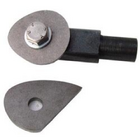
It has a round shaft that can be fixed into the Pro-Forme bar and can be rotated to any shear angle and when attached to a bent or swan's neck bar it presents the scraper tip at a shear scraping angle to the inside surface of the wood. The tip can be sharpened to a traditional or negative scraper profile. Woodcut say that it "fits any of the Pro-Forme tools and can be used as a traditional scraper or can be positioned at an angle in a way no other scrapers can. That produces a shear cut inside a vessel and a super smooth surface."
I'm not referring here to the following Woodcut Pro-Forme Flexi Scraper tip that attaches to the bar in a fixed position that is far less versatile for inside scraping...
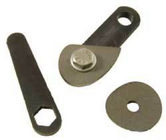
On more open forms I tend to use a bowl gouges in reverse for scraping inside cuts. For that I use a BG with a 65° bevel and an edge profile like the one on the left below. When the area in the front one third of that edge is used in reverse in more open forms you get a genuine shear scrape. If the lip is undercut the further swept back wing edge engages as you come up through that area of the piece and it then becomes a more regular scraping cut...
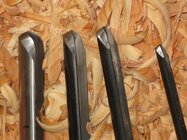
This one...

It has a round shaft that can be fixed into the Pro-Forme bar and can be rotated to any shear angle and when attached to a bent or swan's neck bar it presents the scraper tip at a shear scraping angle to the inside surface of the wood. The tip can be sharpened to a traditional or negative scraper profile. Woodcut say that it "fits any of the Pro-Forme tools and can be used as a traditional scraper or can be positioned at an angle in a way no other scrapers can. That produces a shear cut inside a vessel and a super smooth surface."
I'm not referring here to the following Woodcut Pro-Forme Flexi Scraper tip that attaches to the bar in a fixed position that is far less versatile for inside scraping...

On more open forms I tend to use a bowl gouges in reverse for scraping inside cuts. For that I use a BG with a 65° bevel and an edge profile like the one on the left below. When the area in the front one third of that edge is used in reverse in more open forms you get a genuine shear scrape. If the lip is undercut the further swept back wing edge engages as you come up through that area of the piece and it then becomes a more regular scraping cut...

Back in the day I used to make my own shear scraper (NRS) tip tools. Still use them to this day. Clearly, they aren't for everybody.
I like your method of grinding a slot for the screw. My method of drilling a hole through hardened steel with diamond bits is more work.
The slot was an experiment at first to get around drilling. I was doubtful but over the years, I'd had no problems with rocking like I thought might be possible.I like your method of grinding a slot for the screw. My method of drilling a hole through hardened steel with diamond bits is more work.
Thirty years ago I watched Ray Key cock his scraper up in the air and gently stroke off the finest of shavings. I saw then that it was a technique rather than technology.
A slot is far more convenient than a hole as you don't have to remove the screw to sharpen the blade. I modified a teardrop scraper that came with a hole using a cutoff blade in a Dremel.
It was a joint effort between myself and Neil Strong nad yes we found that the conventional grind lead the wings to chip so changed the angle to give it more strength. But as good as they were they were no match for the hardwoods, so we moved onto carbideWell, I use tantung on my Big Ugly tool. It is a scraper, and is silver soldered onto flat bar stock. I have been debating on sharpening one to a 45 to 50 degree bevel like Tomislav does his scrapers. I would expect to have chipping problems, but thus far have not tried it. Hughie, if you are the person who made solid tantung gouge tips, I would expect it to chip on the gouge edges/wings. Not enough support, especially for some of those hard Aussie woods.... Tantung is excellent for scrapers, and so is stellite.
robo hippy
Today, I found an old Hurricane scraper I lost and forgot about. Turned out, it fell behind one of my workbenches, but not onto the garage floor, instead it fell into this tray that is near the bottom of the legs, which I had a bunch of other stuff on until today. This is a 1 1/2" wide scraper, and its currently ground to just a standard round-nosed scraper shape, and is NOT a negative rake.
I would like to re-grind it into a swept back (on the left side) NRS scraper (I think they are called "french curve" NRS?), as I need one and currently cannot afford a brand new one. It is standard HSS, M2 I figure. I'm curious what the most optimal angles would be for the top and bottom angles.
Looking for opinions and thoughts on which would serve me best here, as this will be used primarily on the inside of bowls. I haven't really used scrapers like this, on the outside of bowls...not sure if they really can be. I currently sheer scrape with my irish grind bowl gouges (have one I re-ground to an irish myself from a 40/40, and then an actual Elseworth that I use his official jig to resharpen at the right angles), which works quite well as far as I can tell. So this particular scraper, I intend to use on the inside of bowls. Sometimes they are smaller...maybe as small as about 4" in diameter, so the angles can potentially be a bit steeper or more extreme. I am also wondering, if a secondary bevel can be ground below the main bevel on the bottom, to help get the thing around corners?
Or, maybe, I think someone mentioned they grind their scrapers with the same angles on the top and bottom, so they can simply flip to scrape with either side (I guess after putting a burr back on), or even scrape with the bowl rotating backwards (I've done that a couple times in the past, when I just couldn't seem to get rid of all my tearout going forwards...which actually seemed to work.)
Anyway. The other NRS I use (or was using) is not mine, and ended up having a chunk taken out of it (not by me...I think if I understood correctly, it was accidentally moved into range of the chuck and its jaws while the a lathe was on.) I have a different scraper I turned into an NRS, its just a round nose, and its never worked all that well. It is a thinner slab of metal, and I may think about what I could do with that later. For now, I'd just like to turn this into an NRS that will work optimally for the inside of bowls.
I would like to re-grind it into a swept back (on the left side) NRS scraper (I think they are called "french curve" NRS?), as I need one and currently cannot afford a brand new one. It is standard HSS, M2 I figure. I'm curious what the most optimal angles would be for the top and bottom angles.
Looking for opinions and thoughts on which would serve me best here, as this will be used primarily on the inside of bowls. I haven't really used scrapers like this, on the outside of bowls...not sure if they really can be. I currently sheer scrape with my irish grind bowl gouges (have one I re-ground to an irish myself from a 40/40, and then an actual Elseworth that I use his official jig to resharpen at the right angles), which works quite well as far as I can tell. So this particular scraper, I intend to use on the inside of bowls. Sometimes they are smaller...maybe as small as about 4" in diameter, so the angles can potentially be a bit steeper or more extreme. I am also wondering, if a secondary bevel can be ground below the main bevel on the bottom, to help get the thing around corners?
Or, maybe, I think someone mentioned they grind their scrapers with the same angles on the top and bottom, so they can simply flip to scrape with either side (I guess after putting a burr back on), or even scrape with the bowl rotating backwards (I've done that a couple times in the past, when I just couldn't seem to get rid of all my tearout going forwards...which actually seemed to work.)
Anyway. The other NRS I use (or was using) is not mine, and ended up having a chunk taken out of it (not by me...I think if I understood correctly, it was accidentally moved into range of the chuck and its jaws while the a lathe was on.) I have a different scraper I turned into an NRS, its just a round nose, and its never worked all that well. It is a thinner slab of metal, and I may think about what I could do with that later. For now, I'd just like to turn this into an NRS that will work optimally for the inside of bowls.
Well, after reading around a bit, I ended up doing a 25/25 degree angle, for a 50 degree included. Took a heck of a long time to get both top and bottom ground to the middle of the bar's thickness, but once I finally reached that point, it was only moments and the burr showed up in just a couple of passes. The swept back side is quite a challenge. I had to take my finer wheel (600 grit) off the grinder to get the angle on one side, but I was eventually able to grind down enough of the material to get a burr in a ways on the swept back side.
Seems like some people prefer a 60 degree included angle, I've also read something (I think by @robo hippy on another forum) about a 70/20 grind for a different kind of NRS. But in this case, I decided on keeping both top and bottom angles the same, which is how the C&S NRS was. IIRC, I think the C&S is a 20/20 (40 degree included) angle, which after reading a few things from Stuart Batty, is what he says is the minimum angle you would ever want to go. I may eventually try a 60 (30/30) degree, depending on how it goes with the 50 degree I just ground. For now, I'm leaving the grinder burr on. I thought my other wheel was a 180 grit CBN, turns out its an 80 grit CBN. I was using my old 350 grit CBN to put on a burr in the past, and it never worked well. The burr from the 80 grit, is much larger, and it showed up to the naked eye right away once I'd ground both top and bottom to the middle. So I'm curious to see how this burr works, and whether I need to bother with burnishing one on or not.
Anyway, still interested in people's thoughts on this. I plan to turn a few bowls and platters over the next week here, and am going to be using this new scraper on each to see how it goes. This is M2 HSS, so, I have no illusions the burr is going to last very long. Maybe once its gone gone, I'll try burnishing a new one on as long as I am able, before I re-grind. In any case....I have been without this "french curve" swept back type NRS for a while now, and I'm looking forward to having one again.
Oh, another thing, with both top and bottom being 25 degree angles, I don't foresee the issues with smaller diameter bowls or tighter angles that I've been getting with my regular scrapers lately. So this thing should take care of most of the issues I have been having lately, I think.
Seems like some people prefer a 60 degree included angle, I've also read something (I think by @robo hippy on another forum) about a 70/20 grind for a different kind of NRS. But in this case, I decided on keeping both top and bottom angles the same, which is how the C&S NRS was. IIRC, I think the C&S is a 20/20 (40 degree included) angle, which after reading a few things from Stuart Batty, is what he says is the minimum angle you would ever want to go. I may eventually try a 60 (30/30) degree, depending on how it goes with the 50 degree I just ground. For now, I'm leaving the grinder burr on. I thought my other wheel was a 180 grit CBN, turns out its an 80 grit CBN. I was using my old 350 grit CBN to put on a burr in the past, and it never worked well. The burr from the 80 grit, is much larger, and it showed up to the naked eye right away once I'd ground both top and bottom to the middle. So I'm curious to see how this burr works, and whether I need to bother with burnishing one on or not.
Anyway, still interested in people's thoughts on this. I plan to turn a few bowls and platters over the next week here, and am going to be using this new scraper on each to see how it goes. This is M2 HSS, so, I have no illusions the burr is going to last very long. Maybe once its gone gone, I'll try burnishing a new one on as long as I am able, before I re-grind. In any case....I have been without this "french curve" swept back type NRS for a while now, and I'm looking forward to having one again.
Oh, another thing, with both top and bottom being 25 degree angles, I don't foresee the issues with smaller diameter bowls or tighter angles that I've been getting with my regular scrapers lately. So this thing should take care of most of the issues I have been having lately, I think.
I make my own out of either German or Dutch HSS as I have a lot of in the way of Cold saw blades and because they seem to make a very high quality steel. Now what grade its I don't know as most saw makers keep that info too themselves.
I make them in the manner of Neil S. and I have at present two basic angles 85 and 20, the 85 is for fine work and 20 is more to do with defining the shape. As to negative scrapers I don't actually own one, preferring to orientate my scrapers in the negative by rolling them over slightly and or lifting the handle.
I make them in the manner of Neil S. and I have at present two basic angles 85 and 20, the 85 is for fine work and 20 is more to do with defining the shape. As to negative scrapers I don't actually own one, preferring to orientate my scrapers in the negative by rolling them over slightly and or lifting the handle.
Attachments
Very interesting method and congratulations for setting a new AAW record for most photos inserted into a single postBack in the day I used to make my own shear scraper (NRS) tip tools. Still use them to this day. Clearly, they aren't for everybody
My first set of turning tools, the Artisan set from Craft Supplies, a long time ago, they had "inside" and "outside" scrapers. These were hold overs from the days before there were chucks. They were intended for the waste block mounts and you turned every thing from the one orientation. One was swept back to the right side, which was the outside scraper, and the other was swept back to the left side, which was the inside scraper. I don't think I heard the term "French curve" shape for a scraper until seeing Tomislav's recent video, but all of mine are shaped pretty much like that. So for a 1 inch scraper, sweeping back to the left side, the nose is kind of square across, and the wing sweeps back maybe almost the width of the scraper blank, so maybe an inch since I don't use scrapers over 1 inch wide. Look up my video "Scary Scrapers", and you can see what I mean.
As for NRSs, I have mine ground at 30/60 on my old platform, which is actually 25/55 since they were all off by about 5 degrees. I have always figured that the NRS needs a certain amount of metal under the burr to make the burr last longer. I did have one ground to 45/45, and it would not even hold a burnished burr, so I ground it to the 30/60. I start off with the grinder burr, and then when it is dull, I burnish it down and then back up. Good for several cycles before taking it back to the grinder. I didn't find it worth the effort to strop the grinder burr off and then go with the burnished burr. The standard skew chisel grind, which is in the 30/30 range, the burr is gone in seconds. If you are turning a 12 by 6 inch deep bowl, the burr won't last for one full sweep before it needs to be refreshed.
robo hippy
As for NRSs, I have mine ground at 30/60 on my old platform, which is actually 25/55 since they were all off by about 5 degrees. I have always figured that the NRS needs a certain amount of metal under the burr to make the burr last longer. I did have one ground to 45/45, and it would not even hold a burnished burr, so I ground it to the 30/60. I start off with the grinder burr, and then when it is dull, I burnish it down and then back up. Good for several cycles before taking it back to the grinder. I didn't find it worth the effort to strop the grinder burr off and then go with the burnished burr. The standard skew chisel grind, which is in the 30/30 range, the burr is gone in seconds. If you are turning a 12 by 6 inch deep bowl, the burr won't last for one full sweep before it needs to be refreshed.
robo hippy
Looks like it’s still only 4 photos per message, but with a single photo containing more than one picture. I do that often since I think 4 pictures are occasionally too limited. But I think I understand possible reasons for the limits.congratulations for setting a new AAW record for most photos inserted into a single post
I simply drag photos onto a common background in photoshop, then use the handy “Save for Web” option, only takes a few seconds.
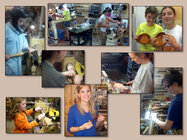
JKJ
My first set of turning tools, the Artisan set from Craft Supplies, a long time ago, they had "inside" and "outside" scrapers. These were hold overs from the days before there were chucks. They were intended for the waste block mounts and you turned every thing from the one orientation. One was swept back to the right side, which was the outside scraper, and the other was swept back to the left side, which was the inside scraper. I don't think I heard the term "French curve" shape for a scraper until seeing Tomislav's recent video, but all of mine are shaped pretty much like that. So for a 1 inch scraper, sweeping back to the left side, the nose is kind of square across, and the wing sweeps back maybe almost the width of the scraper blank, so maybe an inch since I don't use scrapers over 1 inch wide. Look up my video "Scary Scrapers", and you can see what I mean.
As for NRSs, I have mine ground at 30/60 on my old platform, which is actually 25/55 since they were all off by about 5 degrees. I have always figured that the NRS needs a certain amount of metal under the burr to make the burr last longer. I did have one ground to 45/45, and it would not even hold a burnished burr, so I ground it to the 30/60. I start off with the grinder burr, and then when it is dull, I burnish it down and then back up. Good for several cycles before taking it back to the grinder. I didn't find it worth the effort to strop the grinder burr off and then go with the burnished burr. The standard skew chisel grind, which is in the 30/30 range, the burr is gone in seconds. If you are turning a 12 by 6 inch deep bowl, the burr won't last for one full sweep before it needs to be refreshed.
robo hippy
So you use a 30 degree top angle and 60 degree bottom angle? How well does that produce a burr? One of my scrapers is about 55 degrees on the bottom angle, I think. It doesn't seem to get much of a burr, either from grinding or burnishing.
With the 25/25 angle I have now, a bur goes on real easy...in seconds on the grinder, and its a nice big burr... Seems to work much better than any other scraper I've used so far.
interesting...and lengthy read, these 2 pages. All accumulate expressed knowledge/opinions/experience can only lead to one -very broad -conclusion:
There might be an actual or noticeable difference in steel performance...but for most turners - I doubt it. This angle or that angle may/may not offer a slight advantage vs every other.
There many ways to scrape....or flesh out a feline. And - likely they all work. IF the hands of experience are in charge of the tool.....
There might be an actual or noticeable difference in steel performance...but for most turners - I doubt it. This angle or that angle may/may not offer a slight advantage vs every other.
There many ways to scrape....or flesh out a feline. And - likely they all work. IF the hands of experience are in charge of the tool.....
interesting...and lengthy read, these 2 pages. All accumulate expressed knowledge/opinions/experience can only lead to one -very broad -conclusion:
There might be an actual or noticeable difference in steel performance...but for most turners - I doubt it. This angle or that angle may/may not offer a slight advantage vs every other.
There many ways to scrape....or flesh out a feline. And - likely they all work. IF the hands of experience are in charge of the tool.....
Interesting take.
I think, out of this whole thread, there was only one post that offered any kind of scientific conclusions. Even then, I don't know what kind of sample count was referenced. For the most part, everything in here is anecdotal. Its all opinion.
It would be nice to get some more concrete information, statistically sound information, about say steels and how they affect edge longevity and the like. Anecdotally, my C&S M42 gouges last WAY longer than my basic HSS M2 gouges. I used to sharpen every few minutes with my original HSS gouges, The C&S gouges hold an edge so much better, and even when that edge starts to wear down, its gradual, not a sudden shift from "I'm cutting" to "I'm shredding wood unceremoniously."
Its all anecdotal, which is kind of a bummer. I also do astrophotography, and that is a highly contentious and often conflicted community, but one thing I do like about it is, there are a lot of people willing to actually study things and produce their data and statistical results, which is often quite helpful. It would be interesting to see something more scientific with regards to types of steel, and how they perform under various common woodturning circumstances. So its NOT just anedcotes...but instead some well-studied, repeated, verified and statistically valid facts.
I think to have a defined scientific answer might be as illusive as whats the best angle. As getting the best steel and getting the best out of it has many variables. Neil S and my self went through some pretty exhaustive testing on our gouge tips and all the info is here, eg we found a marked difference between 80grit and 1000grit finish in the life of the edge.Interesting take.
I think, out of this whole thread, there was only one post that offered any kind of scientific conclusions. Even then, I don't know what kind of sample count was referenced. For the most part, everything in here is anecdotal. Its all opinion.
It would be nice to get some more concrete information, statistically sound information, about say steels and how they affect edge longevity and the like. Anecdotally, my C&S M42 gouges last WAY longer than my basic HSS M2 gouges. I used to sharpen every few minutes with my original HSS gouges, The C&S gouges hold an edge so much better, and even when that edge starts to wear down, its gradual, not a sudden shift from "I'm cutting" to "I'm shredding wood unceremoniously."
Its all anecdotal, which is kind of a bummer. I also do astrophotography, and that is a highly contentious and often conflicted community, but one thing I do like about it is, there are a lot of people willing to actually study things and produce their data and statistical results, which is often quite helpful. It would be interesting to see something more scientific with regards to types of steel, and how they perform under various common woodturning circumstances. So its NOT just anedcotes...but instead some well-studied, repeated, verified and statistically valid facts.

Just to make sure I understand...illusive, as in illusory, as in an illusion? As in you are not seeing what you think you see or not understanding what you think you are understanding?I think to have a defined scientific answer might be as illusive as whats the best angle. As getting the best steel and getting the best out of it has many variables. Neil S and my self went through some pretty exhaustive testing on our gouge tips and all the info is here, eg we found a marked difference between 80grit and 1000grit finish in the life of the edge.
Or do you mean elusive, as in eluding capture or eluding success? As in you are unlikely to figure out "best angle" because its too hard to define or totally opinion based?
If illusory, then I think you could always correct that, with a better understanding, and I think a more scientific study could help. If elusive, then that would mean it could be challenging to compile a scientific study, but I still think it could help...even if it might be a challenge to do (it might need to be a communal effort, to really get enough data.)
The variables are too many to list in how wear is determine, how tools are sharpened. And - HOW SHARP is "sharp"? What grit? CBN? Aluminum Oxide? How delicate the touch and steady the hands of the user? Both itin sharpening and use of the tool. This...all are "experienced based opinions". And..they are ALL equally valid as such. To at least the one posting said opinion anyway. Ford, Chevy or Mopar.....The controversy continues for as long as conscious thought is available.Interesting take.
I think, out of this whole thread, there was only one post that offered any kind of scientific conclusions. Even then, I don't know what kind of sample count was referenced. For the most part, everything in here is anecdotal. Its all opinion.
It would be nice to get some more concrete information, statistically sound information, about say steels and how they affect edge longevity and the like. Anecdotally, my C&S M42 gouges last WAY longer than my basic HSS M2 gouges. I used to sharpen every few minutes with my original HSS gouges, The C&S gouges hold an edge so much better, and even when that edge starts to wear down, its gradual, not a sudden shift from "I'm cutting" to "I'm shredding wood unceremoniously."
Its all anecdotal, which is kind of a bummer. I also do astrophotography, and that is a highly contentious and often conflicted community, but one thing I do like about it is, there are a lot of people willing to actually study things and produce their data and statistical results, which is often quite helpful. It would be interesting to see something more scientific with regards to types of steel, and how they perform under various common woodturning circumstances. So its NOT just anedcotes...but instead some well-studied, repeated, verified and statistically valid facts.

So I will foist my opinion on you as well
They are just factors. You track it all, which wouldn't be hard. It could be a relatively simple study, with rows for each test and columns for the factors of each test:The variables are too many to list in how wear is determine, how tools are sharpened. And - HOW SHARP is "sharp"? What grit? CBN? Aluminum Oxide? How delicate the touch and steady the hands of the user? Both itin sharpening and use of the tool. This...all are "experienced based opinions". And..they are ALL equally valid as such. To at least the one posting said opinion anyway. Ford, Chevy or Mopar.....The controversy continues for as long as conscious thought is available.
So I will foist my opinion on you as well...they will all work - if one takes time to understand the caveats of each different tool, and steel. Pick what you like, be open to try others, and continue to seek to learn. That is what keeps it all fun and interesting. Cheers! Fun and safe turning!
Global Test Number | Gouge Description | Gouge Iteration | Type of Steel | Grindstone Type Used | Grindstone Grit Used | Length of use Before Regrind | Kind of Use | Description of effectiveness during use
Part of setting up a viable study, would be determining these factors for each test case. There could be dozens of factors. Once you have a specification for each test case, then you run them, repeatedly according to the study specifications, say 7 tests per gouge/grindstone, along with specifications for what you look for and describe when using the gouge for each test case, etc.
I wouldn't say there are too many variables, not at all. In fact, I think they would be quite finite. There would be some subjectivity, in the description of effectiveness, for example. But you can minimize that subjectivity, and biases, with an effective specification for how the tests should be performed, and what aspects of cutting or scraping should be noted during each test case.
I think its eminently doable. Its more whether anyone is even interested in doing such a thing, and I kind of doubt it. Woodworking is a craft, an artform, with a natural medium, and a LOT of it is about the artistic creative aspects with said natural substance.
As this thread demonstrates, though, there are as many opinions as...well, you know how the saying goes.
Clearly, you should do this study.I think its eminently doable. Its more whether anyone is even interested in doing such a thing,
I am going to stand with Kevin. Why not volunteer to do this test? And, know that when you are done....The net benefit will be analogous to peeing yourself in dark pants. It will give you a temporary warm feeling, no one will notice - and the argument will continue.They are just factors. You track it all, which wouldn't be hard. It could be a relatively simple study, with rows for each test and columns for the factors of each test:
Global Test Number | Gouge Description | Gouge Iteration | Type of Steel | Grindstone Type Used | Grindstone Grit Used | Length of use Before Regrind | Kind of Use | Description of effectiveness during use
Part of setting up a viable study, would be determining these factors for each test case. There could be dozens of factors. Once you have a specification for each test case, then you run them, repeatedly according to the study specifications, say 7 tests per gouge/grindstone, along with specifications for what you look for and describe when using the gouge for each test case, etc.
I wouldn't say there are too many variables, not at all. In fact, I think they would be quite finite. There would be some subjectivity, in the description of effectiveness, for example. But you can minimize that subjectivity, and biases, with an effective specification for how the tests should be performed, and what aspects of cutting or scraping should be noted during each test case.
I think its eminently doable. Its more whether anyone is even interested in doing such a thing, and I kind of doubt it. Woodworking is a craft, an artform, with a natural medium, and a LOT of it is about the artistic creative aspects with said natural substance.
As this thread demonstrates, though, there are as many opinions as...well, you know how the saying goes.In the long run, they are never really helpful, and there is really no point in asking anything, when the final outcome is: Try everything yourself and make your own judgement.

You can provide "proof" for anything. Such as the math and photos that proof the Earth is an orb. Yet - we have a contingent of the populace ( some of whom are surprisingly educated...) that will offer their version of "proof" that we live on a flat disk. If you explain that - then you can perform all of the needed research - and convince woodturners of the "supreme scaper". Short of that....? Well.....don't wear dark trousers.
If I had all the tools, I would. I would have to enlist fairly broad community support to do it, which is where I think it would break down. Hence my comment about people being willing to do it.
As if I don't have enough toys I bought a Dwarf II for astrophotography but there hasn't been a star in he sky since I got it.I also do astrophotography, and that is a highly contentious and often conflicted community, but one thing I do like about it is, there are a lot of people willing to actually study things and produce their data and statistical results, which is often quite helpful.
I've never had luck trying to sheer scrape the INSIDE of a bowl with a swept back gouge.
Everyone tries it. Once. Nasty catches.
I've never had luck trying to sheer scrape the INSIDE of a bowl with a swept back gouge.
I usually use a swept back SPINDLE gouge to shear scrape the inside some lidded boxes and these handbell ornaments: drill a hole for depth, remove most of the wood with a parting tool, clean up the bottom and sides a bit with a Hunter tool, then smooth the inside by shear scraping with a 3/8" spindle gouge.
This one cut in half to show the wall shape:
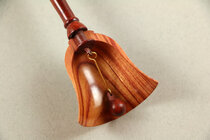

Plan a demo on these in Knoxville in Sept, giving time for people to make some by Christmas if they want.
Time to write another document...
Round or teardrop scrapers on Sorby handles are good to scrape the inside of bowls and closed forms.
JKJ
I have no problem burnishing a burr on my 30/60 NRSs. I do use a carbide rod in a small handle though. With the M42 and V10 metals, you need carbide to turn a burr, the standard card scraper burnishers won't work because they are not hard enough. The grinder burrs are no problem either. This may be me, and my platform. I still do all of my sharpening on platforms, and to date, I have not found a better one then my original.
I am currently turning some bay laurel/myrtle wood. For some reason, the cleanest surface I can get is with my gouges, 1/2 inch on the inside, and 5/8 on the outside. Shear scrape, NRS all make it rougher. I guess it is this particular log. Other bay logs have not been as problematic as this one. Big leaf maple always is....
robo hippy
I am currently turning some bay laurel/myrtle wood. For some reason, the cleanest surface I can get is with my gouges, 1/2 inch on the inside, and 5/8 on the outside. Shear scrape, NRS all make it rougher. I guess it is this particular log. Other bay logs have not been as problematic as this one. Big leaf maple always is....
robo hippy
I usually use a swept back SPINDLE gouge to shear scrape the inside some lidded boxes and these handbell ornaments: drill a hole for depth, remove most of the wood with a parting tool, clean up the bottom and sides a bit with a Hunter tool, then smooth the inside by shear scraping with a 3/8" spindle gouge.
This one cut in half to show the wall shape:
View attachment 75623
Plan a demo on these in Knoxville in Sept, giving time for people to make some by Christmas if they want.
Time to write another document...
Round or teardrop scrapers on Sorby handles are good to scrape the inside of bowls and closed forms.
JKJ
I actually can see a spindle gouge working, especially if it has one of those half-height flutes with more of a u shaped flute (so its flatter). I haven't tried that before. I guess, if I run into a problem like Robo Hippy mentioned where scrapers produce a worse surface, I might try a spindle gouge. With the flatter profile, I can see it actually being possible to get a true sheer scraping orientation. With the deeper V flute of a normal bowl gouge combined with the concave nature of the inside surface, I've never found a way to orient the edge of a bowl gouge in an actual sheer SCRAPING orientation. Its really more of a sheer cut, with the edge wanting to dig into and rip out the wood, rather than lightly shave off the surface...
Perhaps with a relatively open bowl profile, with a shallow curve, it might be possible with a normal bowl gouge. But a spindle gouge makes a lot more sense given its profile....
Everyone tries it. Once. Nasty catches.
Yeah. I blew up a beautiful piece of Aspen the last time I tried, which was a couple of years ago now I think, and I haven't tried since. I really regret it! The heartwood of that piece, had this kind of "starburst" nature where it met the sapwood, so it wasn't just a strait round edge at the interface, it was this complex, very interesting starburst appearance. I had it, too...the bowl was just about done, had this beautiful soft inward (towards the foot) curving profile on both inside and outside....and then...boom.
I actually can see a spindle gouge working, especially if it has one of those half-height flutes with more of a u shaped flute (so its flatter).
No, I use a standard Thompson spindle gouge for this, not the Thompson shallow spindle gouges - I primarily use those for fine detail.
JKJ
- Joined
- Feb 28, 2021
- Messages
- 1,770
- Likes
- 1,582
- Location
- Roulette, PA
- Website
- www.reallyruralwoodworks.com
It takes some tricky finesse to do it. I do that sometimes , but it has to be VERY light touch and VERY precise tool control , so I don't do it when I have to hang the gouge off the tool rest too far (just a tiny twitch you don't even feel yourself making is translated to quite a bit of movement at gouge tip when gouge is hanging off the tool rest too far..) But, it is do-able (I taught myself before I knew it was supposedly a no-no.. LOL) Also I suppose the kind of grind on the gouge makes a difference (Convex shaped wings are pretty important to manage it, too - minimizes the amount of edge touching wood.) It's sort of like the back hollowing technique richard raffan teaches (I've never been able to do it myself, yet) for hollowing out boxes and small bowls with spindle gouge, I guess. key is in getting the bevel support "just right", I think. Also I have only really used it in finish cuts on a twice turned bowl (which is dry and wood doesn't move as much as green wood will while turning)Everyone tries it. Once. Nasty catches.
No, I use a standard Thompson spindle gouge for this, not the Thompson shallow spindle gouges - I primarily use those for fine detail.
JKJ
That still looks like what I was thinking about. The profile is a lot shallower than a bowl gouge. I tested out angles with my spindle gouges, and even my detail gouges, would allow actual sheer scraping on the inside. None of my bowl gouges will, really...they could sheer cut, but not really sheer scrape, and its the cutting that I think is the problem.

